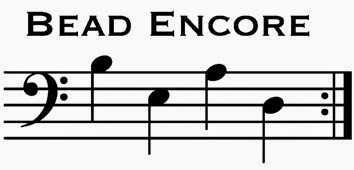I love to have choices! I am by nature a problem solver and I enjoy thinking about different ways to solve any given problem. So here are two ideas for creating variations of the clasp I used in my Heart-to-Heart Bracelet, which is featured in the Aug/Sept. 2013 issue of BEADWORK magazine (pp. 70-73). The clasp is a "bead and loop" type, but for security, it uses two beads that go through one ring (made of farfalle beads, using RAW stitch). Getting the clasp ring just the right size is a little tricky and relies on culling your farfalle beads to choose some of the fatter ones. If that is too fussy for you, here are a couple of alternative ways to finish the clasp.
 |
| pass back down through the 4th bead |
1) Don't change a thing from the printed instructions, but add a second loop of 15º beads. To make the second loop, after adding the two clasp fringes, weave half way around the final RAW unit so that the thread exits the farfalle bead in the last RAW unit that is
opposite the farfalle bead that has the two fringes for the clasp. Pick up 27 size 15º beads; pass back down through the fourth bead picked up, making a loop of 24 beads. Pick up 3 size 15º beads; pass through the farfalle bead. Repeat the entire thread path twice, to reinforce, then secure and trim the thread.
 |
| ready to pick up the last 3 beads |
To use the clasp, you pass
only the 6mm bead on the
long fringe through the RAW farfalle ring. Then pass the 6mm beads,
one at a time, through the second loop made of 15º beads (starting with the
short fringe, then the
long fringe). Using this variation, you don't need to fuss with the size of the RAW farfalle ring since only one of the 6mm fringes needs to fit through it. But you have the security of the second loop: once you pass BOTH 6mm beads through it, they will be tight enough to not slip back out easily.
 |
| the completed loop |
 |
| Variation 1: only the long fringe goes through the RAW ring; both fringes go through the second loop |
2) If you are still working on the bracelet, you can make some modifications to the printed instructions: that is, make the RAW farfalle ring larger than the printed instructions and the two beaded fringes longer. Then add the second loop of 15º beads. With this clasp variation, you will pass both of the fringes through the RAW ring and then pass both of them through the second loop.
- First, when you make the RAW farfalle clasp ring, add one (or two) more RAW units, so that when you close up the ring there are 13 (or 14) farfalle beads at the center of the ring. While the two fringes pass snugly through the original 12-unit ring, this 13- or 14-unit ring will be large enough to allow both 6mm fringes to pass through easily.
- Then, when you make the two clasp fringes, make each of them longer than in the printed instructions. For fringe 1, string 24A, 1E, and 1A. Complete this fringe as in the instructions, except you will pass back through 21A. For fringe 2, string 32A, 1E, and 1A. Complete as in the instructions, passing back through all but the last 3A before adding the final 3A.
- Finally, weave half way around the final RAW unit of farfalle beads so that your thread exits the farfalle opposite the one to which you just added the fringes. Follow the instructions for variation 1 above to add the loop of 15º beads.
To use the clasp, pass the
long fringe through the RAW ring first and then pass the
short one through (they should fit through this larger ring easily). Then pass the
long fringe through the loop of 15ºs, followed by the
short fringe. Easier to use and very secure!
 |
| Variation 2: Larger ring and longer fringes; both fringes pass through the ring and the loop |






